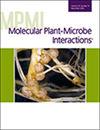求助PDF
{"title":"利用简单化学反应合成的荧光染料对营养和致病真菌细胞中铁的氧化还原状态选择性成像。","authors":"Lala Aliyeva-Schnorr, Niels V Heise, René Csuk, Holger B Deising","doi":"10.1094/MPMI-09-24-0111-SC","DOIUrl":null,"url":null,"abstract":"<p><p>Iron plays a prominent role in various biological processes and is an essential element in almost all organisms, including plant-pathogenic fungi. As a transition element, iron occurs in two redox states, Fe<sup>2+</sup> and Fe<sup>3+</sup>, the transition between which generates distinct reactive oxygen species (ROS) such as H<sub>2</sub>O<sub>2</sub>, OH<sup>-</sup> anions, and toxic OH· radicals. Thus, the redox status of Fe determines ROS formation in pathogen attack and plant defense and governs the outcome of pathogenic interactions. Therefore, spatially resolved visualization of Fe<sup>2+</sup> and Fe<sup>3+</sup> are essential to understand microbial pathogenesis. Here, we report a simple method for synthesis of the redox-state-selective dyes pyrene-tetramethyl piperidinyl oxyl (p-TEMPO) and 4-(4-methylpiperazine-1)-7-nitrobenz-2-oxa-1,3-diazole (MPNBD) for fluorescence microscopy-based imaging of Fe<sup>2+</sup> and Fe<sup>3+</sup> ions. Using these dyes, the occurrence and spatial distribution of Fe<sup>2+</sup> and Fe<sup>3+</sup> ions in vegetative and pathogenic hyphae of the hemibiotrophic maize anthracnose fungus <i>Colletotrichum graminicola</i> are shown. [Formula: see text] Copyright © 2025 The Author(s). This is an open access article distributed under the CC BY-NC-ND 4.0 International license.</p>","PeriodicalId":19009,"journal":{"name":"Molecular Plant-microbe Interactions","volume":" ","pages":"50-55"},"PeriodicalIF":3.4000,"publicationDate":"2025-02-01","publicationTypes":"Journal Article","fieldsOfStudy":null,"isOpenAccess":false,"openAccessPdf":"","citationCount":"0","resultStr":"{\"title\":\"Redox Status-Selective Imaging of Iron in Vegetative and Pathogenic Fungal Cells Using Fluorescent Dyes Synthesized Via Simple Chemical Reactions.\",\"authors\":\"Lala Aliyeva-Schnorr, Niels V Heise, René Csuk, Holger B Deising\",\"doi\":\"10.1094/MPMI-09-24-0111-SC\",\"DOIUrl\":null,\"url\":null,\"abstract\":\"<p><p>Iron plays a prominent role in various biological processes and is an essential element in almost all organisms, including plant-pathogenic fungi. As a transition element, iron occurs in two redox states, Fe<sup>2+</sup> and Fe<sup>3+</sup>, the transition between which generates distinct reactive oxygen species (ROS) such as H<sub>2</sub>O<sub>2</sub>, OH<sup>-</sup> anions, and toxic OH· radicals. Thus, the redox status of Fe determines ROS formation in pathogen attack and plant defense and governs the outcome of pathogenic interactions. Therefore, spatially resolved visualization of Fe<sup>2+</sup> and Fe<sup>3+</sup> are essential to understand microbial pathogenesis. Here, we report a simple method for synthesis of the redox-state-selective dyes pyrene-tetramethyl piperidinyl oxyl (p-TEMPO) and 4-(4-methylpiperazine-1)-7-nitrobenz-2-oxa-1,3-diazole (MPNBD) for fluorescence microscopy-based imaging of Fe<sup>2+</sup> and Fe<sup>3+</sup> ions. Using these dyes, the occurrence and spatial distribution of Fe<sup>2+</sup> and Fe<sup>3+</sup> ions in vegetative and pathogenic hyphae of the hemibiotrophic maize anthracnose fungus <i>Colletotrichum graminicola</i> are shown. [Formula: see text] Copyright © 2025 The Author(s). This is an open access article distributed under the CC BY-NC-ND 4.0 International license.</p>\",\"PeriodicalId\":19009,\"journal\":{\"name\":\"Molecular Plant-microbe Interactions\",\"volume\":\" \",\"pages\":\"50-55\"},\"PeriodicalIF\":3.4000,\"publicationDate\":\"2025-02-01\",\"publicationTypes\":\"Journal Article\",\"fieldsOfStudy\":null,\"isOpenAccess\":false,\"openAccessPdf\":\"\",\"citationCount\":\"0\",\"resultStr\":null,\"platform\":\"Semanticscholar\",\"paperid\":null,\"PeriodicalName\":\"Molecular Plant-microbe Interactions\",\"FirstCategoryId\":\"99\",\"ListUrlMain\":\"https://doi.org/10.1094/MPMI-09-24-0111-SC\",\"RegionNum\":3,\"RegionCategory\":\"生物学\",\"ArticlePicture\":[],\"TitleCN\":null,\"AbstractTextCN\":null,\"PMCID\":null,\"EPubDate\":\"2025/1/27 0:00:00\",\"PubModel\":\"Epub\",\"JCR\":\"Q2\",\"JCRName\":\"BIOCHEMISTRY & MOLECULAR BIOLOGY\",\"Score\":null,\"Total\":0}","platform":"Semanticscholar","paperid":null,"PeriodicalName":"Molecular Plant-microbe Interactions","FirstCategoryId":"99","ListUrlMain":"https://doi.org/10.1094/MPMI-09-24-0111-SC","RegionNum":3,"RegionCategory":"生物学","ArticlePicture":[],"TitleCN":null,"AbstractTextCN":null,"PMCID":null,"EPubDate":"2025/1/27 0:00:00","PubModel":"Epub","JCR":"Q2","JCRName":"BIOCHEMISTRY & MOLECULAR BIOLOGY","Score":null,"Total":0}
引用次数: 0
引用
批量引用

 求助内容:
求助内容: 应助结果提醒方式:
应助结果提醒方式:


